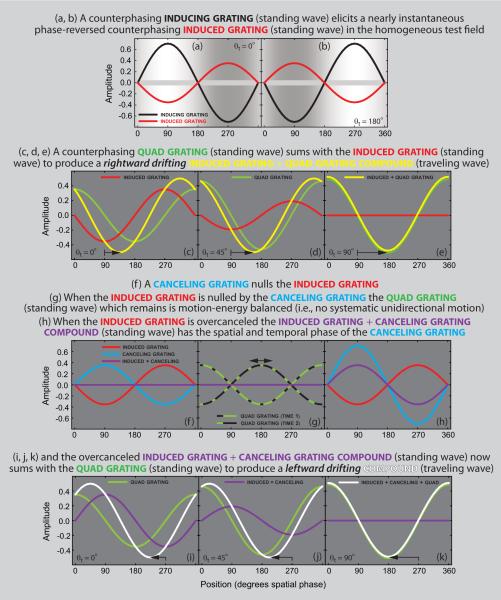Fig. 2.
In the quadrature-phase motion technique a counterphasing inducing grating (standing wave) [a, b (black line)] produces a nearly instantaneous phase-reversed counterphasing induced grating (standing wave) [a, b (red line)] in the homogeneous test field of a grating induction display. A counterphasing quadrature grating (standing wave in 90° spatial and temporal phase relative to the induced grating) [c–e (green line)] sums with the induced grating (standing wave) [c–e (red line)] to produce a rightward drifting induced-plus-quadrature grating compound (traveling wave) [c–e (yellow line)] to which the visual system is extremely sensitive. The temporal phase of the quadrature grating can be varied to measure the phase (time) lag of induction. To measure the magnitude of induction the temporal phase of the quadrature grating is held constant at 90° phase relative to the induced grating, and a second luminance grating is added to the test field. This second “canceling” grating [f, h (blue line)] possesses the same spatial and temporal frequency as the induced grating, but is 180° out of spatial phase with it. The canceling grating is added to the test field at a number of contrast levels, using the method of constant stimuli. When canceling grating contrast is less than induced grating contrast (i.e., when the induced grating is under-canceled) the compound grating possesses the spatial and temporal phase of the induced grating. It therefore combines with the quadrature grating to produce a rightward moving traveling wave just as in the case where no canceling grating is present [c–e (yellow line)]. When canceling grating contrast exceeds induced grating contrast (i.e., when the induced grating is over-canceled) the compound grating now possesses the spatial and temporal phase of the canceling grating [h (purple line)]. This compound combines with the quadrature grating to produce a leftward moving traveling wave [i–k (white line)]. When canceling grating contrast equals induced grating contrast the sum is zero (i.e., the induced grating is nulled) [f, g (purple line)]. The motion energy of the counterphasing quadrature grating which remains is left/right balanced (i.e., a standing wave) [g (green/black lines)] yielding a 50:50 proportion of left/right motion judgments in a forced-choice motion direction discrimination task.

